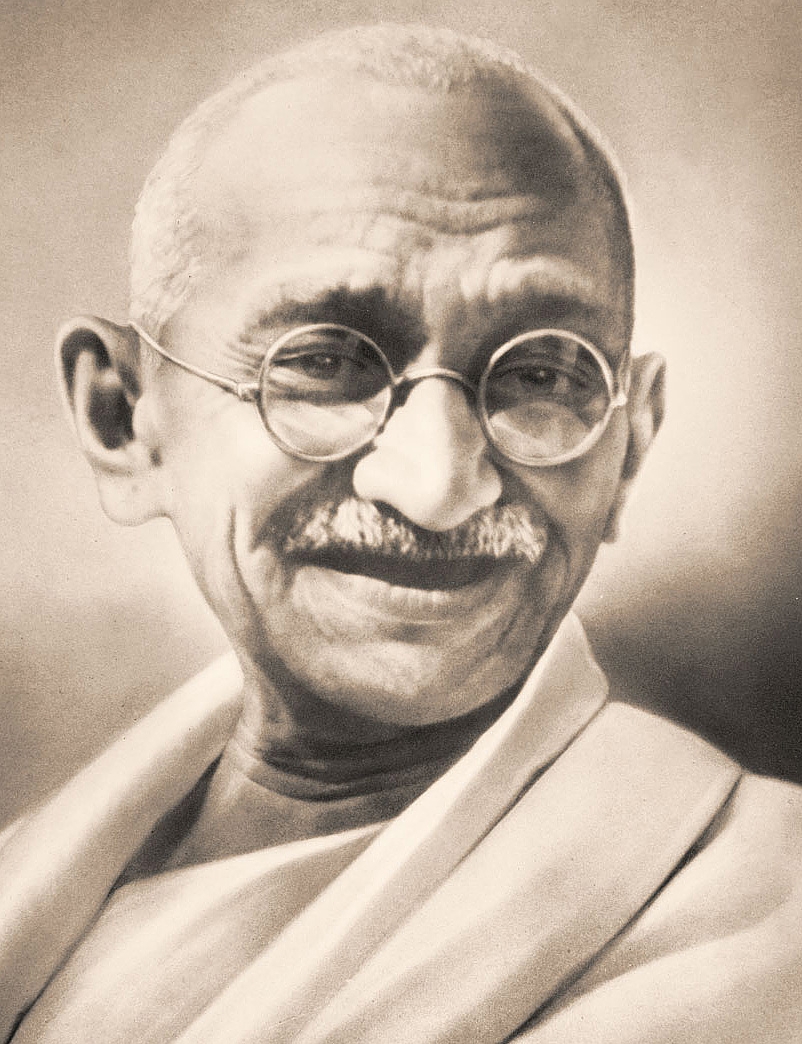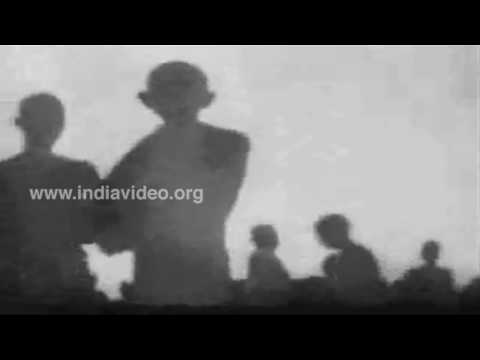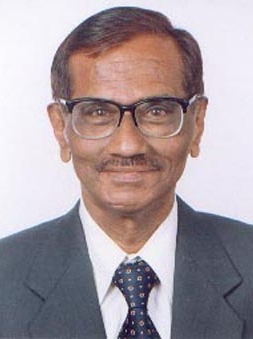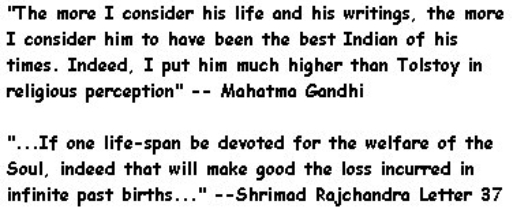Mahatma Gandhi: Truth, Non-Violence And Jainism

The Gandhian life was a legendary quest of Experiments with Truth, which was his autobiography. For the Mahatma Truth and Non-violence were interchangeable terms. It was out of these he honed his invincible weapon of Non-violent Non-Co-operation Satyagraha, which ultimately won India her freedom.
Truth and non-violence were convertible terms for Gandhiji. There was no compromise. It was this he called Satyagraha, a quest for truth at all costs. In 1930, in his historic Dandi March the Mahatma to the remote seaside village of Dandi, about 320 km from Ahmedabad.
Salt had been heavily taxed by the British for over 40 years and Dandi March was a symbolic mass protest.
 |
Dandi March or Salt Satyagraha led by Gandhi
On March 12, 1930, an unforgettable day in the History of India, after having informed the Viceroy of what he intended to do Gandhi proceeded to the sea cost at Dandi to break the law which deprived the poor man of his right to make his own salt.
It was a 24-day march of 241 miles, followed by seventy-eight inmates of Gandhi’s ashram at Sabarmati, both men and women. Tens of thousands of people along either side of his route waited for a glimpse of Gandhi and his followers, hours before for the entourage came by.The satyagraha march, which triggered the wider Civil Disobedience Movement, was an important part of the Indian independence movement. It was a campaign of nonviolent protest against the British salt tax in colonial India which began with the Salt March to Dandi on March 12, 1930. It was the most significant organized challenge to British authority since the Non-cooperation movement of 1920-22, and the Purna Swaraj declaration of independence by the Indian National Congress on December 31, 1929. Mohandas Karamchand Gandhi led the Dandi march from his Sabarmati Ashram to Dandi, Gujarat to produce salt without paying the tax, with growing numbers of Indians joining him along the way. Salt Satyagraha.
Mahatma Gandhi's biographer, Louis Fischer, once said that his greatness "lay in doing what everyone could do but doesn't". Gandhi's Salt March to Dandi in 1930 can be examined as a version of this message. Through the relentless pursuit of his non-violent non-co-operation Gandhiji ultimately gave the clarion call: “Chale Jaao” Get out to the mighty British Empire in 1942, which led India to freedom in 1947’
And much to the disgust of Churchill, who was appalled by the "nauseating and humiliating spectacle of this one time Inner Temple lawyer, now seditious fakir, striding half-naked up the steps of the Viceroy's palace to parley on equal terms with the representative of the King-Emperor", for the first time the British were forced to talk eye-to-eye with the leader of a subject nation.
And it was indeed prophetic of him to declare: “Assaults have been made on my life in the past, but god has spared me till now, and the assailants have repented for their action. But if someone were to shoot me in the belief that he was getting rid of a rascal, he would kill not the real Gandhi., but the one that appeared to him a rascal.”… “I am not aching for martydom, but if it comes in my way in the prosecution of what I consider to be the supreme duty in defence of the faith I hold... I shall have earned it.” The Mind of Mahatma Gandhi, R.K. Prabhu and U.R. Rao OUP London, March 1945. MM, 9
And the Mahatma became immortal in his relentless pursuit of truth and ahimsa when he was assassinated on 30th January 1948. Please see my article:
Gandhi imbibed these principles-guiding stars of his life- since his childhood. Before he left for his Bar-at-Law studies in London he was administered oaths to abstain from wine, women and meat by the family Jain guru Pandit Bechardas by his mother. When Gandhi returned from London after completing his studies he was introduced by, Dr. Mehta introduced me to several friends, one of them being his brother Shri Revashankar Jagjivan, with whom there grew up a lifelong friendship.
But the introduction that I need particulary take note of was the one to the poet Raychand or Rajchandra, the son-in-law of an elder brother of Dr. Metha, and partner of the firm of jewellers conducted in the name of Revashankar Jagjivan. He was not above twenty-five then, but my first meeting with him convinced me that he was a man of great character and learning. He was also a Shatavadhani (one having the faculty of remembering or attending to a hundred things simultaneously), and Dr. Mehta recommended me to see some of his memory feats.
As Gandhiji states “I exhausted my vocabulary of all the European tongues I knew, and asked the poet to repeat the words. He did so in the precise order in which I had given them. I envied his gift without, however, coming under its spell. The thing that did cast its spell over me I came to know afterwards. This was his wide knowledge of the scriptures, his spotless character, and his burning passion for self-realization. I saw later that this last was the only thing for which he lived…”
Mahatma Gandhi was deeply influenced (particularly through the guidance of Shrimad Rajchandra) by Jain tenets such as peaceful protective living and honesty, and made them an integral part of his own philosophy. Jainism has a very distinct idea underlying Tirthankara worship. The physical form is not to be worshiped, but it is the Gunas (virtues, qualities) which are praised. Tirthankaras are only role-models, and sects such as the Sthanakavasi stringently reject the appearance of worshipping statues.
(Source: The Collected Works of Mahatma Gandhi, Volume 36, Item 535, page 466. This was intended as a preface the "Shrimad Rajchandra” which he had been asked to write by Revashankar Jagjivan, Shrimad's business partner and paternal uncle-in-law.)
http://www.facebook.com/ShrimadRajchandra?filter=3
Mahatma Gandhi on Shrimad Rajchandra and Anekantvad
Mahatma Gandhi wrote: “I very much like his (Raychandbhai's) doctrine of manyness (anekantavad) of reality. It saves me from attributing motives to my opponents and critics....today I can love them because I am gifted with the eye to see myself as others see me and vice versa.”
In his pen portrait of Shrimad, Gandhiji writes: “While many Christian missionary friends considered their religious duty to convert me to Christianity on the ground of its wonderful vows of charity, chastity, faith and hope, I made up my mind that I should first find out whether the religion of my birth namely Hinduism, gave me the message that I needed.”
“And I asked a few fundamental questions on Hinduism to Shri Raychandbhai by post and his replies were so logical, so appealing and convincing that I regained my faith in Hinduism and I was saved from conversion of religion. From that moment onwards, my respect and admiration for Raychandbhai increased in leaps and bounds and I considered him to be my religious guide till he lived.”
In his autobiography: “I have since met many a religious leader or teacher. I have tried to meet the heads of various faiths, and I must say that no one else has ever made on me the impression that Raychandbhai did. His words went straight home to me. His intellect compelled as great a regard from me as his moral earnestness, and deep down in me was the conviction that he would never willingly lead me astray and would always confide to me his innermost thoughts. In my moments of spiritual crisis, therefore, he was my refuge...Source: Young India, January 21, 1926, p.30(Gandhiji on Shrimad's spirituality in the midst of activity by Shrimad Rajchandra on Friday, June 20, 2008 at 5:34am)
“Raychandbhai's commercial transactions covered hundreds of thousands. He was a connoisseur of pearls and diamonds. No knotty business problem was too difficult for him. But all these things were not the centre round which his life revolved. That centre was the passion to see God face to face. Amongst the things on his business table there were invariably to be found some religious book and his diary. The moment he finished his business he opened the religious book or his diary..... The man who, immediately on finishing his talk of weighty business transactions, began to write about the hidden things of the spirit could evidently not be a businessman at all, but a real seeker after truth.”
The principles of truth and non-violence which Gandhiji thus imbibed were to be tested and perfected during his South African sojourn.Ruskin’s Unto This Last cast a deep influence on him and Tolstoy’s The Kingdom of God is Within You cast a deep spell on him:
“It was forty years back, when I was passing through a severe crisis of scepticism and doubt, that I came across Tolstoy’s book The Kingdom of God is Within You, and was deeply impressed by it. I was at that time a believer in violence. Its reading cured me of my scepticism and made me a firm believer in ahimsa. What has appealed to me most in Tolstoy’s life is that he practised what he preached and reckoned no cost too great in his pursuit of truth. Take the simplicity of his life, it was wonderful. Born and brought up in the midst of luxury and comfort of a rich aristocratic family, blessed in an abundant measure with all the stores of the earth that desire can cover, this man who had fully known all the joys and pleasures of life turned his back upon them in the prime of his youth and afterwards never once looked back....He was the greatest apostle of non-violence that the present age has produced. No one in the West, before him or since \, has written and spoken on non-violence so fully or insistedntly and with such penetration and insight as he, I would even go further and say that his remarkable development of this doctrine puts to shame the present-day narrow and lop-sided interpretation put upon it by the votaries of ahimsa in this land of ours. In spite of India’s proud claim of being the karmabhumi, the land of relalization, and in spite of some of the greatest discoveries in the field of ahimsa that our ancient sages have made, what often goes by the name of ahimsa among us today is a travesty of it. True ahimsa should mean a complete freedom from ill will and anger and hate and an overflowing love for all. For inclulcating this true and higher type of ahimsa amongst us, Tolstoy’s life with its ocean-like love should se\rve as a beacom light and a never failing source of inspiration.”
Yet the Mahatma was humble enough to state “There is no such thing as ‘Gandhism’ and I do not want to leave any sect after me. I do not claim to have originated any new principle or doctrine. I have simply tried in my own way to apply the eternal truths to our daily life and problems. There is, therefore, no question of my leaving any code like the code of Manu. The opinion that I have formed and the conclusions I have arrived at are not final, I may change them tomorrow. (cf.Emerson: a foolish consistency is the hobgoblin of little minds.) I have nothing new to teach to the world. Truth and non-violence are as old as the hills. all I have done is to try experiments in both on as vast a scale as I could do. In doing so, I have sometimes erred and learnt by my errors. Life and its problems have thus become to me so many experiments in the practice of truth and non-violence. by instinct, I have been truthful, but not non-violent. As a Jain muni once rightly said, I was not so much a votary of ahimsa, as I was of truth. In fact, it was in course of my pursuit of truth that I discovered non-violence. Our scriptures have declared that there is no dharma higher than truth. But non-violence they say, is the highest duty. The word dharma, in my opinion, has different connotations as used in the two aphorisms.”
“How am I to convince the world by means of books that the whole of my constructive programme is rooted in non-violence? My life alone can demonstrate it.” (Mahatma, life of Mohandas Karamchand Gandhi. Published by the Publications Division, Ministry of Information and Broadcasting, Govt. of India, New Delhi) MT, VI, 177.
Truth & Non-Violence
“I am but a poor struggling soul yearning to be wholly good-wholly truthful and wholly non-violent in thought, in thought, word and deed; but ever failing to reach the ideal which know to be true. It is painful climb, but the pain of it is a positive pleasure to me. each step upward makes me feel stronger and fit for the next.”
Ahimsa and Truth.
“Ahimsa and Truth are so intertwined that is it practically impossible to disentangle and separate them. They are like two sides of a coin, or rather a smooth unstamped metallic disc. Who can say which is the obverse, and which is reverse? Nevertheless, ahimsa is the means; Truth is the end. Means to be means must always be within our reach, and so ahimsa is our supreme duty. If we take of the means, we are bound to reach the end sooner or later.When once we have grasped this point final victory is beyond question. Whatever difficulties we encounter, whatever apparent reverses we sustain, we may not give up the quest for Truth which alone is, being God Himself.”
Yet Gandhiji was bold enough to state: “ I do not believe in the exclusive divinity of the Vedas. I believe the Bible, the Koran and the Zend Avesta, to be as much divinely inspired as the Vedas. My belief in the Hindu scriptures does not require me to accept every word and every verse as divinely inspired...I decline to be bound by any interpetation, however, learned it may be, it it is repugnant to reason or moral sense.”
God is Truth, Truth is God
“I would say with those who say ‘god is Love’, God is Love. But deep down in me I used to say that though God may be Love, God is Truth above all. If it is possible for the human tongue to give the fullest description of God, I have to the conclusion that God is Truth. Two years ago I went a step further and said that Truth is God. You will see the fine distinction between between the two statements, god is Truth and Truth is god. You came to that conclusion after a continuous and relentless search after truth which began fifty years ago. I then found that the nearest approach to truth was through love."
“It was because of this reasoning that I saw that rather than say that god is Truth, I should say that Truth is god. Add to this the great difficulty, that millions have taken the name of god and in His name committed nameless atrocities. Not that scientists very often do not commit atrocities in the name of Truth, Then there is another thing in Hindu philosophy, namely, god alone is and nothing else exists, and the same truth you see emphasized in the kalma of Islam. And there you find it clearly stated that god alone is, and nothing else exists. In fact. the Sanskrit word for truth is a word which literally means that which exists, sat,.For these and many reasons, I have come to the conclusions that the definition-Truth is God- gives me the greatest satisfaction.And when you want to find Truth as God, the only inevitable means is love, that is, non-violence, and since I beleive that ultimately tha means and ends are convertible terms, I should not hesitate to say that God is Truth.”
I would like to refer here to Swedish Nobel Prize winner in Economics for his Asian Drama Prof.Gunnar Myrdal on the Gandhian contribution to the issue of economic amd social justice: Prof. Myrdal sums up the Gandhian ethose in these words: “Gandhi, although he strove to and actually did maintain and over the years even intensified- his ties with tradition and religion, was in this context (of equality) more than in any other a true Westernized liberal, indeed, a radical and a revolutionary, whose demand for drastic changes in the social and economic order was heard throughout the subcontinent. Until Gandhi’s crusade, social and economic reforms were discussed very little, either in India or anywhere else South Asia. Gandhi’s egalitarianism became one of the links between him and rationalistic intellectuals of Nehru’s type who were relatively unconcerned with tradition and religion.” (p.754).
But Prof. Myrdal thinks that the Gandhian legacy is complex particularly in regard to economic equality. He observes that Gandhiji by ‘his stress on the principle of trusteeship, and his friendliness toward many in exalted economic positions, (he) established a pattern of radicalism in talk but conservation in action that is still very much a part of the Indian scene’. (p.750) (emphasis added).
Yet Prof. Myrdal has no doubts as regards the essential Gandhian faith in economic equality. He points out that Gandhiji firmly believed that freedom would be followed swiftly by social and economic revolution. “ To him such a revolution was inevitable.” And if drastic reforms were not introduced with the drawn of independence Gandhiji feared violent uprising of the suffering multitudes. Prof. Myrdal quotes Gandhiji;
“ A non-violent system of government is clearly an impossibility so long as the wide gulf between the rich and the hungry millions persists. The contrast between the palaces of New Delhi and the miserable hovels of the poor, labouring class cannot last one day in a free India in which the poor will enjoy the same power as the richest in the land. A violent and bloody revolution is a certainty one day unless there is a voluntary abdication of riches and the power that riches give and sharing them for the common good.” (P.786-87)
And in stressing the need for engending popular enthusiasm for schools as community centers and teachers as intellectual and moral leaders Prof. Myrdal pays the handsomest compliment to the pervasive influence Gandhiji had. He says: “This is not the first time in the course of this study that the writer has found himself thinking that not only India, but the other South Asian countries as well have need of another Gandhi- or rather a great number of them - who would away the upper classes and would walk the country roads and inspire the people in their villages.” (p.1824) (Emphasis added). http://balpatil.wordpress.com/2010/09/03/appreciation-of-bal-patil%E2%80%99s-review-of-prof-gunnar-myrdal%E2%80%99s-asian-drama/
Even more radically the Mahatma boldly declared:“I suggest that we are thieves in a way. If I take anything that I do not need for my own immediate use, and keep it, I thieve it from somebody else. I venture to suggest that it is the fundamental law of Nature, without exception, that Nature produces enough for our wants from day to day, and if only everybody took enough for himself and nothin more, there would be no pauperism in this world, there would be no man dying of starvation in this world. But so long as we have got this inequality, so long as we are thieving. I am no socialist and I do not want to dispossess those who have got possessions; but I do say that, personally, those of us who want to see light out of darkness have to follow this rule. I do not want to dispossess anybody. I should be then departing from the rule of ahimsa. If sombody else possesses more than I do, let him. But so far as my own life has to be regulated, I do say that I dare not possess anything which I do not want. In India we have got three millions of people having to be satisfied with one meal a day, and that meal consisting of a chapati containing no at in it, and a pinch of salt. You and I have no right to anything that we really have until these three millions are clothed and fed better. You and I who ought to know better, must adjust our wants, and even undergo voluntary starvation in order than they may be nursed and clothed.”
That is the sum and substance of the perennial Gandhian message conveyed through Truth and non-violence. As Einstein said on the Mahatma’s assassination: “Generations to come will scarce believe that such a one as [Gandhi] ever in flesh and blood walked upon this earth."
 Bal Patil
Bal Patil


